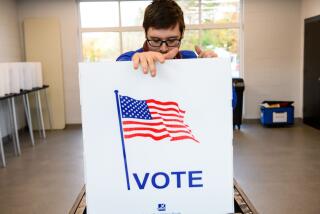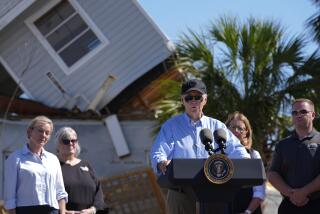Florida’s Homeless May Be Andrew’s Lasting Legacy : Hurricane: Upward of 250,000 people have lost their residences and thousands of businesses no longer exist.
FLORIDA CITY, Fla. — Manuel and Naomi Farias walked sadly through the remnants of his father’s home, devastated by Hurricane Andrew last week. Naomi clutched two framed photographs, all they found in the house where Manuel grew up and his father lived for 15 years.
“Everything is all gone,” Manuel said. “It’s all under the rubble. . . . All our memories, everything.”
His father was safe, evacuated before the storm hit. But the community itself had nowhere to hide.
“It doesn’t look like a town no more,” Manuel said. “It’s . . . nothing. The trees are naked or gone. It’s just open space. It’s a whole other world.”
Nearly a week after Hurricane Andrew pulverized South Florida, many of the storm’s victims are realizing that they have joined the ranks of America’s homeless, and perhaps the jobless.
In the battered, debris-strewn communities of South Florida, up to 250,000 people lost their homes or saw them rendered uninhabitable. Another 25,000 were displaced in Louisiana. Along with the battered homes, thousands of businesses, stores and small shops were destroyed--taking jobs with them.
The most immediate needs of emergency shelter, food and drinking water have been met, thanks to hundreds of volunteers and the arrival of the first of more than 20,000 federal troops.
Now the task is to rebuild--lives as well as homes.
“People want to know what’s going to happen to them,” said Otis Wallace, the mayor of Florida City. “But I can’t give them a total solution to their lives. There is no quick fix. No one is living today like they were yesterday.”
In a vacant lot next to City Hall, just yards from where Wallace spoke, was a haunting vision of desperation. Beneath a blue morning sky, hurricane victims picked through piles of clothing and some food that had been left on the ground overnight. The clothing was soaking wet and some had been scattered by the wind, but throughout the morning people who had been left with little more than what they wore on their backs came to root around, looking for something to salvage.
“This is the worst natural disaster in the history of America in terms of economic impact, devastation and homelessness,” said Art Teele, a Dade County commissioner.
Georgia Brinson worked for years in the J. R. Brooks Packing House, putting avocados, limes and carambola into boxes for shipment around the world. The packing house lies in ruins, as does Brinson’s home.
“It hurts to think about the future,” said Brinson, 39, a mother of three who was waiting at Homestead Elementary School to receive food and clothing vouchers from the American Red Cross.
“I’m a working woman,” she said. “I sometimes worked two shifts a day, 7 a.m. to 11 p.m. But I can’t even think about working until I can have a comfortable place to lay my head at night.”
To Carolyn Washington-White, a homemaker without a home, the ordeal seemed endless. “It’s been the longest week in history,” she said as she and her husband sought temporary work. Their normal routine has been replaced with standing in lines, searching for food and foraging for elusive information about where to go for aid. “It’s only been a week,” she said, “but it feels like a month.”
Gov. Lawton Chiles, in a statewide televised address Sunday night, said life in North Miami, Miami proper and Miami Beach had returned to normal, although nighttime curfews remained in effect. But Chiles added, “It will be months before we can restore normalcy in much of South Dade.” He said it would cost at least $20 billion to rebuild.
The death toll from Hurricane Andrew remained unchanged, with officials tying 17 deaths in Florida directly to the storm. Four deaths were reported in the Bahamas and one in Louisiana. Several others died in the storm’s aftermath, electrocuted by downed power lines, crushed in car accidents or felled by heart attacks, bringing the overall death toll to 33.
Scores of people were unaccounted for. The Miami Herald printed messages from 94 people Sunday seeking missing loved ones. Some people have taken to communicating by painting messages in large letters on their abandoned houses.
“Grandma Newton is OK,” read one such message spray painted on a roofless house near City Hall.
Another missive, painted on a house near a highway: “Thanks for caring, everyone.”
Adding to the doomsday look were squads of soldiers in fatigues, Florida National Guard troops carrying M-16s and convoys of relief supplies being escorted into the devastated 200-square-mile area south of Miami by police vehicles with sirens screaming.
Gen. Gordon R. Sullivan, the Army’s chief of staff, toured South Florida Sunday with a team of Army commanders to assess the relief efforts. He was to report to President Bush at the end of his one-day visit. The President spent the day at Camp David, Md.
At a press conference, Sullivan said soldiers would remain in the area for at least 30 days, adding that the Pentagon will send more help if necessary.
The Rev. Jesse Jackson, who toured the devastated areas Sunday and spoke and prayed at several area churches, compared what he saw in South Florida to the damage inflicted by the 1988 earthquake in Armenia. “This is far beyond what has been projected on television,” he said at Homestead City Hall. “But here we have a greater opportunity to bring relief by training people to be a part of the reconstruction.”
Teele, the Dade County commissioner who accompanied Jackson, said that if those left homeless by the hurricane could be equipped to rebuild, “nobody would be on welfare or unemployment here for 20 or 30 years. We can have full employment out of this if we think this through clearly.”
In fact, some of the victims were already being hired to help cope with the disaster. About 15 people lined up in a Homestead Elementary School classroom, hoping to be among the first of 2,000 who would get $6-an-hour cleanup jobs from the Florida Department of Labor. “I’ll have some of these people working within the hour,” vowed administrator Larry McIntyre.
Thousands of farm workers also hoped for jobs. “There are many people who have no cars, no gas and nowhere to go,” said Aurelia Sanbeck, 43, of Florida City. “So they are waiting. But they are not sure anyone is helping them.”
The federal government has come under harsh criticism from local officials and hurricane victims for its slow response to the disaster. In Washington on Sunday, Vice President Dan Quayle and Transportation Secretary Andrew H. Card Jr. defended the Bush Administration’s conduct.
“The relief effort is well under way, and there has not been any foot-dragging,” Quayle said on CBS’s “Face The Nation.”
“This has been a very prompt response to a disastrous situation. . . . It is a disaster beyond anybody’s expectation . . . and I would say considering the circumstances, we’ve done a very good, commendable job.”
Card, appointed by President Bush to head the relief task force, also defended the Adminstration--but acknowledged that there had been problems.
“I think the federal response really came quickly, but it was not enough,” he said on ABC’s “This Week With David Brinkley.” “No one realized the magnitude of this disaster.”
More to Read
Sign up for Essential California
The most important California stories and recommendations in your inbox every morning.
You may occasionally receive promotional content from the Los Angeles Times.










